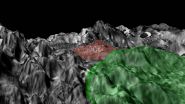30 years after C60: Fullerene chemistry with silicon
A long strived-for silicon dodecahedron synthesised at room temperature
2015-03-18
(Press-News.org) This news release is available in German.
FRANKFURT. The discovery of the soccer ball-shaped C60 molecule in 1985 was a milestone for the development of nanotechnology. In parallel with the fast-blooming field of research into carbon fullerenes, researchers have spent a long time trying in vain to create structurally similar silicon cages. Goethe University chemists have now managed to synthesise a compound featuring an Si20 dodecahedron. The Platonic solid, which was published in the "Angewandte Chemie" journal, is not just aesthetically pleasing, it also opens up new perspectives for the semiconductor industry.
The Si20 dodecahedron is roughly as large as the C60 molecule. However, there are some crucial differences between the types of bonding: All of the carbon atoms in C60 have a coordination number of three and form double bonds. In the silicon dodecahedron, in contrast, all atoms have a coordination number of four and are connected through single bonds, so that the molecule is also related to dodecahedrane (C20H20). "In its day, dodecahedrane was viewed as the 'Mount Everest' of organic chemistry, because it initially could only be synthesized through a 23- step sequence. In contrast, our Si20 cage can be created in one step starting from Si2 building blocks," explains Prof. Matthias Wagner of the Goethe University Institute of Inorganic and Analytical Chemistry.
The Si20 hollow bodies, which have been isolated by his PhD student, Jan Tillmann, are always filled with a chloride ion. The Frankfurt chemists therefore suppose that the cage forms itself around the anion, which thus has a structure-determining effect. On its surface, the cluster carries eight chlorine atoms and twelve Cl3Si groups. These have highly symmetric arrangements in space, which is why the molecule is particularly beautiful. Quantum chemical calculations carried out by Professor Max C. Holthausen's research group at Goethe University show that the substitution pattern that was observed experimentally indeed produces a pronounced stabilisation of the Si20 structure.
In future, Tillmann and Wagner are planning to use the surface-bound Cl3Si anchor groups to produce three dimensional nanonetworks out of Si20 units. The researchers are particularly interested in the application potential of this new compound: "Spatially strictly limited silicon nanoparticles display fundamentally different properties to conventional silicon wafers," explains Matthias Wagner. The long strived-for access to siladodecahedrane thus opens up the possibility of studying the fundamental electronic properties of cage-like Si nanoparticles compared to crystalline semiconductor silicon.
INFORMATION:
[Attachments] See images for this press release:

ELSE PRESS RELEASES FROM THIS DATE:
2015-03-18
This news release is available in French. With a population likely to grow 27% by 2031, putting an end to urban sprawl in Greater Montreal appears impossible for the short to medium term. But it is possible to slow the pace of urban sprawl by harnessing the full development potential of central areas, according to forecasts by Guillaume Marois, a recent Ph.D. from INRS who has developed a spatial microsimulation model called Local Demographic Simulations (LDS).
These findings are presented in an article co-authored by Guillaume Marois and Professor Alain Bélanger ...
2015-03-18
Women who have difficulty getting pregnant often turn to in-vitro fertilization (IVF), but it doesn't always work. Now scientists are taking a new approach to improve the technique by studying the proteins that could help ready a uterus for an embryo to implant in its wall. Their report could help researchers develop a new treatment that could potentially increase the success rate of IVF. The study appears in ACS' Journal of Proteome Research.
Chen Xu, Hu Zhou and colleagues note that nearly 50 million couples worldwide require some kind of medical intervention to conceive. ...
2015-03-18
New York (18 March 2015)--"Consensual unions," two people living in the same dwelling in a relationship akin to marriage, have been an integral part of family life in Latin America for centuries. In fact, in Latin America, legal marriages and consensual unions are seen as similarly acceptable family arrangements for bearing and raising children. However, consensual unions have historically been more common among disadvantaged populations and in rural areas than among more advantaged populations and in urban areas--indicating that such unions are rooted in limited economic ...
2015-03-18
Plastic products advertised as biodegradable have recently emerged, but they sound almost too good to be true. Scientists have now found out that, at least for now, consumers have good reason to doubt these claims. In a new study appearing in the ACS journal Environmental Science & Technology, plastics designed to degrade didn't break down any faster than their more conventional counterparts.
Susan Selke, Rafael Auras and colleagues note that to deal with our plastic waste problem, many countries and local governments have adopted laws, such as single-use bag bans, to ...
2015-03-18
Green tea's popularity has grown quickly in recent years. Its fans can drink it, enjoy its flavor in their ice cream and slather it on their skin with lotions infused with it. Now, the tea could have a new, unexpected role -- to improve the image quality of MRIs. Scientists report in the journal ACS Applied Materials & Interfaces that they successfully used compounds from green tea to help image cancer tumors in mice.
Sanjay Mathur and colleagues note that recent research has revealed the potential usefulness of nanoparticles -- iron oxide in particular -- to make biomedical ...
2015-03-18
In early January, almost 3 million gallons of wastewater from a hydraulic fracturing ("fracking") operation in North Dakota spilled into nearby creeks. The accident highlighted ongoing concerns about what's in fracking fluids and wastewater, and whether they pose a threat to human health or the environment. An article in Chemical & Engineering News (C&EN), the weekly newsmagazine of the American Chemical Society, details what scientists are doing to answer these questions.
Celia Henry Arnaud, a senior editor at C&EN, notes that figuring out what potential harm fracking ...
2015-03-18
This news release is available in Japanese.
Researchers at the Okinawa Institute of Science and Technology Graduate University (OIST) have demonstrated a more robust method for controlling single, micron-sized particles with light.
Passing light along optical microfibers or nanofibers to manipulate particles has gained popularity in the past decade and has an array of promising applications in physics and biology. Most research has focused on using this technique with the basic profile of light, known as the fundamental mode. Researchers in the OIST Light-Matter ...
2015-03-18
Why do some countries seem to develop quickly while others remain poor? This question is at the heart of the so-called poverty or development trap problem. Using mathematics on open data sets researchers now present new insights into this issue, and also suggest which countries can be expected to develop faster. The paper is published in the journal Big Data.
Why do some countries seem to develop quickly while others remain poor? This question is at the heart of so-called poverty or development trap problem. Development economists have identified several potential causes ...
2015-03-18
Submarine groundwater discharge (SGD) consists of a mixture of continental freshwater and seawater, which recirculates through the coastal aquifer. In addition to its importance in the water cycle, as a potentially exploitable water resource and a source of water for brackish coastal environments such as marshes and coastal lagoons, it also can serve as an important source of dissolved chemical compounds such as nutrients and trace and toxic metals.
Now, a study led by researchers from the Institute of Environmental Science and Technology (ICTA) and the Department of ...
2015-03-18
Scientists have produced a new map of the Moon's most unusual volcano showing that its explosive eruption spread debris over an area much greater than previously thought.
A team of astronomers and geologists, led by experts in the Institute for Computational Cosmology and Department of Earth Sciences at Durham University, UK, studied an area of the lunar surface in the Compton-Belkovich Volcanic Complex.
By mapping the radioactive element thorium which spewed out during the eruption they discovered that, with the help of the Moon's low gravity, debris from the unnamed ...
LAST 30 PRESS RELEASES:
[Press-News.org] 30 years after C60: Fullerene chemistry with silicon
A long strived-for silicon dodecahedron synthesised at room temperature


